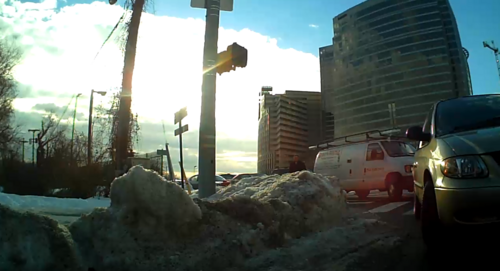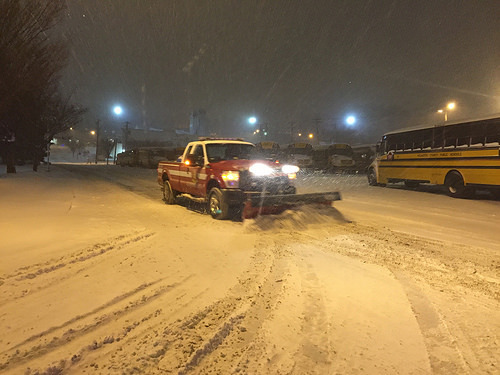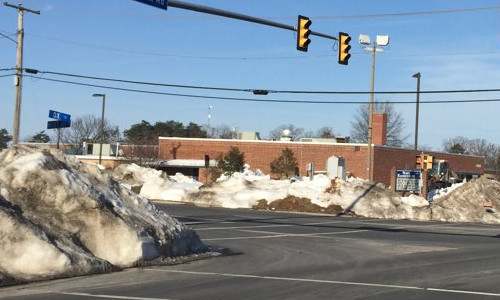If students were cars, schools would have opened sooner
Many of the region’s schools closed for a full week after the recent blizzard, leaving parents to scramble for childcare and students missing out on valuable classroom time. That’s what happens when your storm recovery efforts prioritize making it easy to drive rather than giving everyone a safe way to move around.
The historic storm hit the DC area on Friday, January 22nd. By the time the last flakes fell on Saturday night, just about everything was covered in over two feet of powdery, slippery, transportation-crippling snow.
It was soon pretty easy to drive, but not get around by any other means
As crews throughout the region got to work on their respective snow clearing plans (impressive work for which they deserve a lot of thanks), roads became passable and then completely clear. In contrast, sidewalks, curb cuts, and bus stops were often blocked not just by snow, but also frozen slush.
Some of the area’s bike trails were cleared, but access points were plowed in, and the network as a whole was not rideable. Metro returned to service, but getting to stations was a dirty, icy, boulder-climbing adventure and plowed-in bus stops left people waiting often in very busy streets.
Without good options, the only choice left for most people was to drive, clogging our already strained roadways that the remaining snow had narrowed.
As the week wore on and roads became clear, adults returned to work. But faced with the conditions that would have left children walking and waiting for buses in the streets, school officials decided there were not enough safe routes to school, and kept most of the region’s schools closed for the entire week.

DC’s 5th and Sheridan NW, the Tuesday after the storm. To the right on 5th (the street going left to right) is Coolidge High School. To the left is Whittier Education Campus. Photo by Julie Lawson.
This didn’t happen randomly. Arlington is an example of why.
These conditions were a result the fact that our systems for clearing snow focus first on getting cars moving again. People walking and biking are, at best, an afterthought in the region’s snow clearing plans.
For example, Arlington posts a clearly thought-out snow operations plan on their snow operations web page:
- Phase I: During the storm, county crews keep the arterial and collector roads as functional as possible to make sure that emergency access like EMS, fire, police, utility trucks etc. could still get through.
- Phase 2: Immediately after the storm, they keep working those major corridors, widening lanes so everybody else could start driving again, too.
- Phase 3: When those are under control they start working their way into residential streets.
Arlington has no unified public plan for clearing the rest of the transportation network - the sidewalks, trails, curb cuts and bus stops that are necessary for people walking, biking and taking transit.
Private individuals are responsible for clearing the majority of sidewalks, and various agencies of the County government are responsible for some routes. Apparently, there are designated “safe routes to schools” that are meant to get priority in snow clearing, but those routes are not made public and are not given priority if the schools are closed. However, many stretches are left without anyone to clear them, unless the County chooses to on an ad-hoc, complaint-based basis.
For example, the stretch of sidewalk along Lynn Street between the intersection of Lee Highway and the Key Bridge is along National Park Service Property. After this storm it took more than a week before the snow and ice were clear along this stretch, which cut off the main sidewalk access between Rosslyn and DC.

Arlington’s “Intersection of Doom,” at Lee Highway and N Lynn Street, just south of the Key Bridge. People walking and biking would need to climb over this snow/ice mound to get to the iced over sidewalk that leads to Key Bridge. Photo by the author.
When this snow plan was implemented, the streets were cleared, but the sidewalks and bus stops students would have needed to get to school were covered, often in mounds of snow deposited by snow plows. Instead of forcing kids to walk or wait for buses in the street, officials closed most of the region’s schools for the entire week after the snow storm, forcing students to lose valuable instructional time at the end of the grading period.
Meanwhile, the region began to get back to work. By Wednesday, after three full days of being closed to allow the region to focus on digging out, most business were open and workers were working.
There are other ways to do this
During and immediately after the late winter blizzard of 1996 that dumped about the same amount of snow as last week’s storm, New York City shut down all streets in Manhattan to private cars. The only vehicles on the roads were emergency equipment, garbage trucks, transit vehicles and of course snow plows.
NYC-DOT knew it could never get the city up and running again quickly if they decided that their first priority was to make it possible for everybody to drive their cars again. Roads were opened to traffic only after the sidewalks and bus stops were clear. In New York this took two days.
Arlington could do the same thing: Clear just enough of the roadway to accommodate emergency and service vehicles and eventually transit, but not more. With virtually no cars on the roads, people could at least get around on foot without putting their lives in danger.
And because transit and school bus stops would be cleared and almost no traffic on the road, these buses could actually get through and run on normal schedules. All kids, walkers and bus riders alike, would have a safe way to get to school.
Arlington does transportation well… when it doesn’t snow
Fortunately, a good model exists right under our own noses. Arlington’s transportation program looks at mobility as a public right, and sees all modes as legitimate. This includes mobility for people in cars, but doesn’t leave out people on bikes, people on transit and people on foot.
Arlington’s snow operations planners should try looking at mobility the same way when they plan for snow removal.
In this storm we saw a snow removal plan focused on getting cars back on the road. That happened by Wednesday. But cars don’t occupy desks at schools.

After snow storms, it’d be smart to prioritize getting schools up and running. Photo by Arlington County on Flickr.
Our public schools closed for a week because there wasn’t a safe way for kids to get to them. We need a transportation system that serves the students, whether they drive, ride the bus, walk or bike to school.
We didn’t have that after the recent blizzard, so we didn’t have school.

